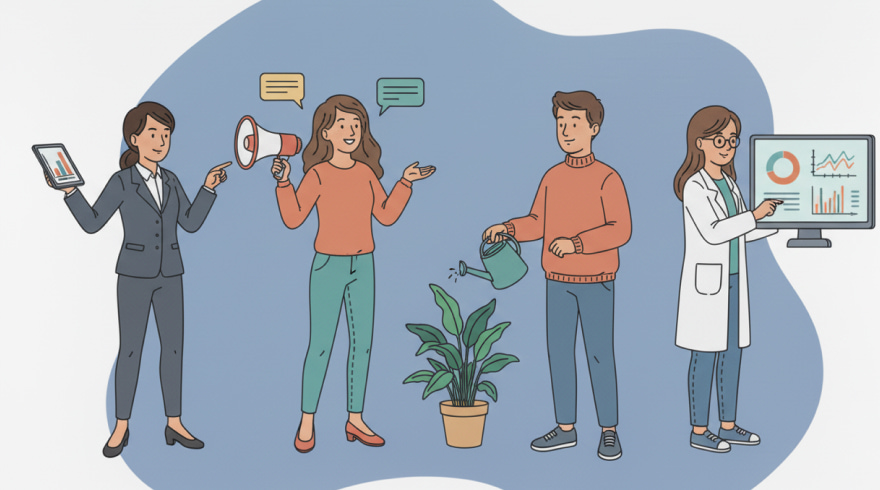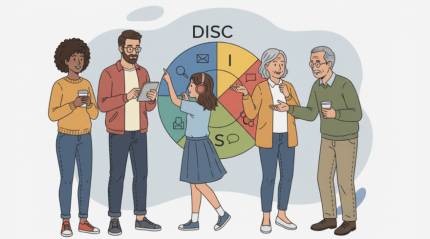A Complete Guide to Communication Personality Profiling for Better Conversations
- 23 October 2025

Take DISC Personality Assessment Online
Get StartedWhat Is a Communication Personality Assessment?
Every day, professionals navigate meetings, negotiations, and quick check-ins where words, tone, and timing shape outcomes. A communication personality assessment maps the recurring patterns behind those moments so people can adapt in real time. Instead of guessing how to phrase an idea, you gain a shared language for intent, listening, and clarity. That shared language reduces friction, helps set expectations, and improves outcomes without forcing anyone into a rigid mold.
These assessments typically examine preferences such as directness, pace, emotional expression, and tolerance for ambiguity. In team settings, the results add context to misunderstandings and reveal strengths hidden by stress or unclear roles. Across workshops and coaching sessions, the communication personality test can clarify feedback loops and reduce avoidable friction. The goal is practical: to surface repeatable habits that make collaboration smoother and more humane.
- Spot patterns in how you initiate, respond, and follow up.
- Translate abstract traits into specific conversational behaviors.
- Build psychological safety by normalizing diverse interaction styles.
- Reduce rework by aligning message structure to audience needs.
- Accelerate onboarding with a common vocabulary and frameworks.
Unlike generic training decks, a good assessment ties insight to daily micro-moments, opening a meeting, disagreeing respectfully, giving praise, or summarizing decisions. With that bridge from theory to practice, people move faster, cut confusion, and protect attention for the work that matters.
How It Works: Models, Dimensions, and Data
Under the hood, most instruments collect responses to scenario-based prompts and then calculate patterns across dimensions such as assertiveness, sociability, information density, and comfort with conflict. The resulting profile highlights tendencies, not destiny; think of it as a compass rather than a cage. Quality tools balance quantitative scoring with qualitative guidance so you can test, learn, and iterate as contexts change.
| Framework | Primary Focus | Communication Angles | Typical Blind Spots |
|---|---|---|---|
| DISC | Observable behavior | Directness, pace, priority | Oversimplifying nuance |
| Big Five (OCEAN) | Trait spectrum | Openness to dialogue, emotional tone | Abstract without applied prompts |
| Social Styles | Interpersonal stance | Emotive control, responsiveness | Labeling without context |
Most platforms present results as a narrative plus a visual map, then add scenario tips for emails, 1:1s, and group discussions. For clarity in action plans, a personality test communication style label should be treated as a starting hypothesis, not a fixed identity. Over time, the most useful feature is the feedback loop, capture a moment, test a tweak, and watch friction fade as signals become easier to read.
- Question design matters: avoid items that reward “desirable” answers over truthful ones.
- Context shifts the signal: stress, deadlines, and hierarchy can amplify or mute tendencies.
- Calibration is essential: revisit results after role changes or major team reorgs.
- Team rollups help leaders anticipate collaboration bottlenecks in advance.
With sound psychometrics and thoughtful coaching, assessments evolve from one-off novelty into a durable operating system for communication.
Benefits for Teams, Leaders, and Customer-facing Roles
When teams align on interaction norms, conversations move from reactive to intentional. Meetings become shorter because messages land on the first pass. Feedback feels safer because it’s framed with shared vocabulary. Onboarding accelerates because new colleagues can decode preferences early, sidestepping months of trial and error. Sales, support, and success teams also gain a strategic edge by tailoring cadence, tone, and structure to each buyer or user.
Leaders often report better decision quality once they diversify how information is presented, bullet summaries for speed, stories for context, and data visuals for depth. When mapping customer journeys, a personality communication test insight helps reps personalize scripts without sounding scripted. In cross-functional work, the same insight reduces status meetings by enabling asynchronous updates that match recipients’ attention patterns.
- Cut miscommunication costs by clarifying intent and next steps quickly.
- Build resilience by distinguishing stress behavior from baseline preferences.
- Improve inclusion by honoring different processing speeds and voices.
- Raise customer satisfaction through adaptive messaging and pacing.
- Enhance leadership pipelines with stronger coaching and delegation habits.
The compounding effect shows up in culture: fewer misunderstandings, faster decisions, and more trust during high-stakes moments.
Preparation, Ethics, and Best Practices
Preparation starts with context setting: explain why you’re using an assessment, how data will be stored, and how results will (and won’t) influence evaluations. Participants should take the instrument when rested, without external pressure, and on a device that supports thoughtful reading. Remind everyone that profiles describe likely tendencies, not fixed identities; humans change with experience, incentives, and environment.
- Be explicit about privacy and consent; allow opt-outs without penalty.
- Avoid weaponizing profiles in performance conversations.
- Pair assessments with coaching, not just a PDF report.
- Encourage experiments: tweak email subject lines, meeting formats, or follow-up cadence.
- Reassess after significant role shifts to keep guidance relevant.
Ethically, the bar is clear: no stereotyping, no gatekeeping, and no assumptions about capability based on a code or color. Good practice replaces labels with behaviors, how to phrase a request, when to ask a check question, and what medium to use. Over months, those small, consistent behaviors create durable improvements in trust and throughput.
Interpreting Results and Turning Insight Into Habits
Reading a profile is only step one; the real payoff comes from translating patterns into repeatable micro-behaviors. Start by picking one recurring situation, a weekly stand-up, a stakeholder update, or a discovery call, and build a tiny playbook. Set an intention, script a first sentence, anticipate a likely reaction, and plan a follow-up question to check understanding. Keep the loop small so you can observe cause and effect.
- 30–60–90 plan: pick one behavior to test per month, not twelve at once.
- Design prompts: “If the room goes quiet, ask a clarifier instead of repeating the point.”
- Signal switch: match channel to complexity, short notes for quick decisions, documents for depth.
- Feedback tokens: invite one micro-note after meetings to validate what worked.
Track outcomes like meeting length, revision counts, or win rates to quantify progress. Over time, your default style stays authentic while your range expands. That combination, clarity plus adaptability, builds credibility faster than charisma alone. Treat the process as ongoing calibration: you’re not chasing a personality, you’re mastering a portfolio of conversational moves suited to changing conditions.
FAQ: Common Questions About Communication Profiling
Is this the same as a clinical evaluation?
No. Communication profiling is a workplace development tool, not a clinical instrument. It spotlights conversational tendencies and helps you run targeted experiments in meetings, email, and presentations. If you need mental health support, consult licensed professionals.
How accurate are the results?
Accuracy depends on design quality, honest responses, and context. Results are directional, highlighting patterns to test rather than laws to obey. The most reliable approach pairs a solid instrument with coaching and real-world experiments that confirm or refine the guidance.
Can results change over time?
Yes. New roles, managers, stress levels, and organizational norms can shift how you show up. Think of profiles as snapshots under certain conditions. Revisit them after big transitions and update your playbooks accordingly.
Should teams share their profiles?
Sharing can be helpful when it’s voluntary and accompanied by clear norms. Teams benefit when members explain preferences for feedback, decision-making, and meeting structure. However, never force disclosure or use labels as shortcuts for judgment.
How do I start improving right away?
Pick one recurring situation and script a small change: a clearer subject line, a tighter agenda, or a better check-for-understanding question. Gather quick feedback, iterate for two weeks, and then add another micro-habit. Small, compounding improvements beat one-time overhauls.
Finally, remember that tools don’t create trust, people do. Use insights to listen better, ask smarter questions, and make it easier for others to succeed with you.



